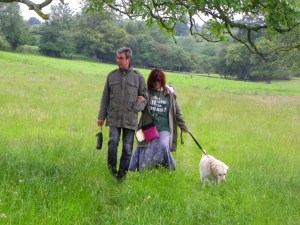After spending much of the previous night indulging in the Olympics Opening Ceremony, I was not feeling my shiniest on Saturday July 28th. But by the time I was sitting on the bus chugging off to Bromyard my “left over night” feeling had disappeared. I like the spirited journeys out to Bromyard and Brockhampton, and this one did not disappoint.
The purpose of the day was to give an overview of what we have learned so far about the Studmarsh site. We also had to decide where to dig the archaeological trenches. The Studmarsh site has many “humps and bumps” beneath its long grass, so we need to target the dig carefully given the fact that we only have two weeks to complete it.
Archaeologists Ian and Chris discussed the results of the Site Survey carried out in the rainy season of June/July, and showed off their new gadget, affectionately referred to as Lidar Duck. For the more serious-minded, LIDAR is an acronym for Light Detection and Ranging. http://www.english-heritage.org.uk/professional/research/landscapes-and-areas/aerial-survey/archaeology/lidar/
This impressive piece of kit gives incredibly accurate (within 2m) measurements of land surface from an aerial view, so in an area like Studmarsh where the grass is long and there are many uneven areas of ground, the humps and bumps can be properly mapped out.
Historian Kate Lack gave a detailed overview of the relevant finds from our historical research groups. Please refer to the History Page for Kate’s written update, including extracts from the “Tabloid” headlines associated with Cradley Parish in 1397! (Not for the prudish). When I translated the Latin from the Visitation records for Cradley I was struck by the scene of desolation and desperation reaped by the Black Death. Beneath the salacious headlines which would embarrass most daily Red Tops, there is a sense of hellish suffering in the day-to-day lives of local inhabitants.
One of the strands of the Past in Mind project is to explore mental health within the framework of archaeology and history. Many volunteers in the group, including myself, experience or have experienced times of mental distress. Although this is not the focus of the project, it is important that we acknowledge it.
With this in mind I was asked to begin a general discussion about the project and how volunteers are finding it in relation to their every day lives. What follows is a snapshot of Past in Mind volunteers glimpsed through some individual responses.
Mark: “It’s given me the confidence to open up and talk in front of others about mental health”.
Chris said that the project has opened things up for him which he has not tried before, such as studying history. Although his father has always been keen on metal detecting, the Past in Mind project is a new experience for him. Chris feels enabled to do more things on his own since becoming a volunteer.
Mark said that it is good to be with others again and he is glad there are some service users he knows among the volunteers. Mark mentioned the leaning castle of Bridge North which once featured on Time Team, one of his favourite TV programmes. Ian commented that it was surprising how little had been found during the Bridge North excavation despite the famous “leaning castle”.
Helen admitted she feels a bit worn out, but she really enjoyed the Site Survey in June/July – particularly the hands-on use of archaeological equipment such as the Prism and Total Station.
Jenny said that when she began this project she didn’t know much about history or archaeology and she has enjoyed exploring new ideas.
Kate stated that all the volunteers are on the same level no matter what their level of expertise, as we do not know what we might discover in relation to the Studmarsh site. She enjoys channelling the group to try to find answers.
Helen likened the project to the TV programme “Deal or no Deal”, explaining that when we dig the archaeological trenches in August we do not know which trench, if any, will yield something valuable.
Mel said that she has found the project double-edged. She has had to confront some personal past experiences which have been quite emotional. It has been exhausting for her, although she has also found it a very positive thing to do. Mel said that she had not expected the project to have this effect on her.
Judith sometimes finds it difficult to concentrate as her attention is often caught by interesting but irrelevant details when she is researching texts. It is easy to lose focus as there are so many details she wishes to pursue.
Claire said that she too has experienced mixed emotions through being involved with this project, although it has been an exciting challenge.
Mel claimed that when she first started out with this project all its strands seemed very separate and she couldn’t see the relevance of some of the earlier research. But now the content is overlapping more and the project makes sense. Today (July 28th) is the first day that it all seems to fit together.
Trudy the project Labrador, moaned and grumbled throughout the discussion as she was not the topic of conversation.
We talked about many other things including the role of technology and communication, but I would never finish this Blog post if I detailed everyone’s contributions! This snapshot account captures the project and its volunteers before the eagerly anticipated dig, which is scheduled to start on August 13th.
Please refer to the Contacts Page if you wish to find out more or get involved.


